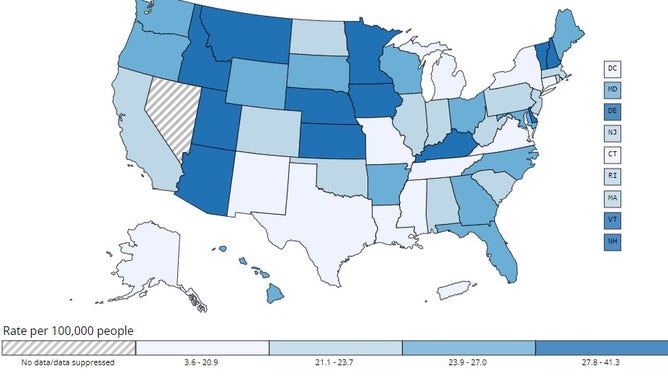The states with the highest skin cancer rates just might surprise you
May is Skin Cancer and Melanoma Awareness Month, and May 1 is Melanoma Monday. FOX Weather details which states are those with the highest risks of skin cancer.
Staying safe during sunburn season
Fox News Medical Contributor Dr. Janette Nesheiwat on protecting your skin from the sun during the spring and summer months.
Spring fever has hit the nation, and young and old are running out to enjoy the warm temperatures and longer days. But the Centers for Disease Control warns that more sun leads to the most common type of cancer in the U.S. – skin cancer.
The states with the highest rates of skin cancer and melanoma might surprise you.
Utah topped the chart for the highest rates of new skin melanomas, according to a CDC study run between 2015 and 2019. Over 40 people per 100,000 residents reported a new skin cancer in that time.
Vermont, Minnesota, New Hampshire and Iowa rounded out the top 5 states. Arizona, home of the Valley of the Sun, ranked a mere No. 12, with 27.8 out of 100,000 residents reporting new cancer.

Between 2015 and 2019, for every 100,000 people 23 reported new melanomas and 2 of them died of the cancer.
(CDC, US Department of HHS, National Cancer Institute, US Cancer statistics Working Group / FOX Weather)
7 FACTS YOU NEED TO KNOW ABOUT THE UV INDEX TO KEEP YOU SAFE
The territory with the lowest rate of skin cancer boasts some of the nation’s best beaches and snorkeling. Only 3.6 per 100,000 tropical Puerto Rico residents were diagnosed with melanoma.
Even the land of the midnight sun, where Utqiagvik, Alaska, doesn’t see the sun for more than two full months, had a higher incidence rate. Alaska reported a 14.1 new skin cancer rate and tied with Texas.
ALASKA TOWN SEES SUN FOR FIRST TIME IN 65 DAYS
Melanoma Monday
The first Monday in May, Melanoma Monday, kicks off Skin Cancer and Melanoma Awareness Month. Organizations use the day and the month to raise awareness of the symptoms, causes and prevention of the disease. The American Academy of Dermatology urges everyone to wear black on Monday. The black ribbon symbolizes skin cancer.

The Skin Care Foundation urges those impacted by skin cancer to post their stories on social media and tag #ThisIsSkinCancer.
(Skin Cancer Foundation / FOX Weather)
MANY OF US HAVE A VITAMIN D DEFICIENCY AND DON'T KNOW IT, RESEARCHERS SAY
About 9,500 Americans are diagnosed with skin cancer every day, according to the AAD. Over their lifetime, about 2.2% of us, or 1 of every 50, will be diagnosed with melanoma. The American Cancer Society estimates that almost 98,000 of us will be diagnosed with melanoma this year, and almost 8,000 will die from it.
Melanoma is the deadliest type of skin cancer, states the AAD. It is the third most common type of skin cancer that begins in the cells that give skin its color. The ACS states that melanoma accounts for about 1% of all skin cancers but a large majority of skin cancer deaths.

Melanoma on the tip of the nose in a 72-year-old man.
(GIRAND/BSIP/Universal Images Group / Getty Images)
FOUNTAIN OF YOUTH? THESE ARE THE BEST AND WORST STATES FOR YOUR SKIN
Anyone can get melanoma. It is one of the most common cancers in young adults, according to the ACS. Those with a family history are at high risk. The ACS states that about 1 in 38 White people will get melanoma in their lifetime, 1 in 1,000 Black people and 1 in 167 Hispanic people. The chance of getting melanoma also increases with age.
Skin cancer is preventable
The AAD claims that skin cancer is one of the most preventable cancers.
"The best way for people to prevent skin cancer is to protect themselves from the sun," states the CDC.
7 THINGS TO KNOW ABOUT SUNSCREEN

A woman sunbathing
(Sean Gallup/Getty Images / Getty Images)
Cover skin with sunscreen, a minimum of SPF 15, all year round, recommends the CDC. Wear protective clothing and try to stay in the shade. UV can reflect off surfaces like water, cement, sand and snow.
"Even on a cloudy day, you can still get a sunburn," Dr. Janette Nesheiwat told FOX Weather. "And this is really important to understand because repetitive sunburns, especially if you have at least five or more in your lifetime, doubles your risk of melanoma, which is a skin cancer."

Melanoma on the neck.
(Girand/BSIP/Universal Images Group / Getty Images)
WHAT TO KNOW WHEN CHOOSING YOUR NEXT PAIR OF SUNGLASSES
She tells her patients to use at least a 30 SPF, which blocks about 97% of UVA rays. She uses SPF 50 and avoids prime burning hours between 10 a.m. and 4 p.m. The doctor stresses that reapplication is important. Unprotected skin can burn in as little as 15 minutes.
"Any type of sunburn is a very serious health concern because it causes damage to your DNA, and repetitive damage to your DNA leads to what's called basal cell carcinoma, squamous cell carcinoma and melanoma, which all three are the most common types of skin cancers that we see," Nesheiwat continued.
